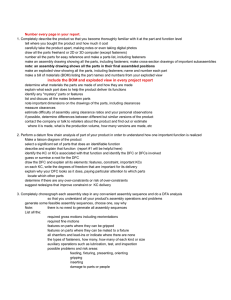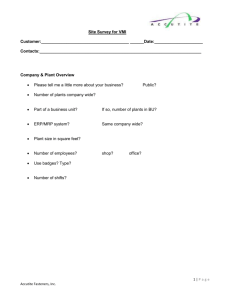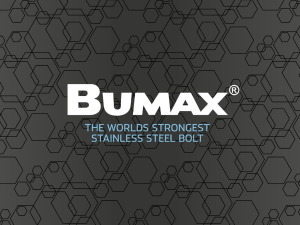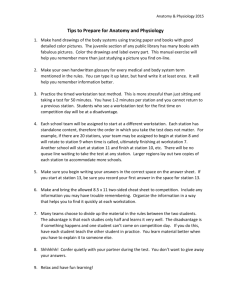Project Deliverables
advertisement
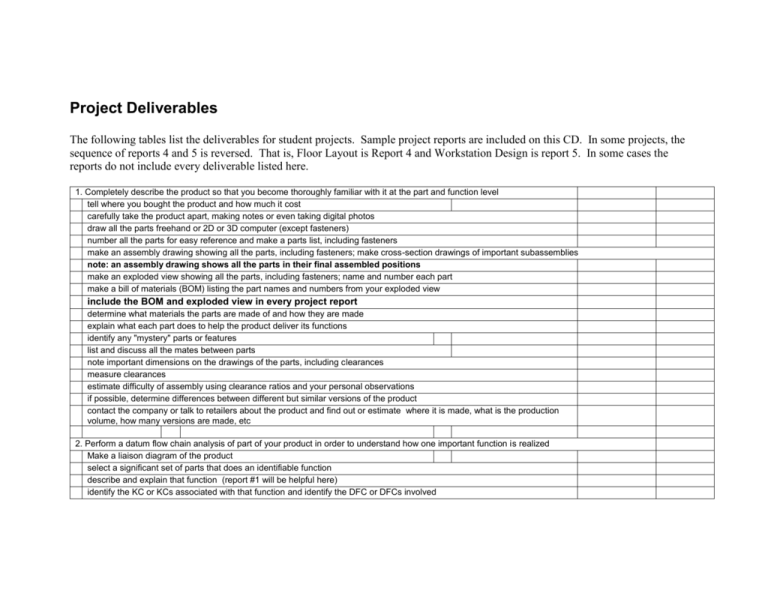
Project Deliverables The following tables list the deliverables for student projects. Sample project reports are included on this CD. In some projects, the sequence of reports 4 and 5 is reversed. That is, Floor Layout is Report 4 and Workstation Design is report 5. In some cases the reports do not include every deliverable listed here. 1. Completely describe the product so that you become thoroughly familiar with it at the part and function level tell where you bought the product and how much it cost carefully take the product apart, making notes or even taking digital photos draw all the parts freehand or 2D or 3D computer (except fasteners) number all the parts for easy reference and make a parts list, including fasteners make an assembly drawing showing all the parts, including fasteners; make cross-section drawings of important subassemblies note: an assembly drawing shows all the parts in their final assembled positions make an exploded view showing all the parts, including fasteners; name and number each part make a bill of materials (BOM) listing the part names and numbers from your exploded view include the BOM and exploded view in every project report determine what materials the parts are made of and how they are made explain what each part does to help the product deliver its functions identify any "mystery" parts or features list and discuss all the mates between parts note important dimensions on the drawings of the parts, including clearances measure clearances estimate difficulty of assembly using clearance ratios and your personal observations if possible, determine differences between different but similar versions of the product contact the company or talk to retailers about the product and find out or estimate where it is made, what is the production volume, how many versions are made, etc 2. Perform a datum flow chain analysis of part of your product in order to understand how one important function is realized Make a liaison diagram of the product select a significant set of parts that does an identifiable function describe and explain that function (report #1 will be helpful here) identify the KC or KCs associated with that function and identify the DFC or DFCs involved guess or surmise a root for the DFC draw the DFC and explain all its elements: features, constraint, important KCs explain why your DFC looks as it does, paying particular attention to which parts locate which other parts determine if there are any over-constraints or risk of over-constraints suggest redesigns that improve constraint or KC delivery 3. Completely choreograph each assembly step in any convenient assembly sequence and do a DFA analysis so that you understand all your product's assembly operations and problems generate some feasible assembly sequences, choose one, say why Note: there is no need to generate all assembly sequences List all the: required gross motions including reorientations required fine motions features on parts where they can be gripped features on parts where they can be mated to a fixture all chamfers and lead-ins or indicate where there are none the types of fasteners, how many, how many of each kind or size auxiliary operations such as lubrication, test, and inspection possible problems and risk areas: feeding, fixturing, presenting, orienting gripping inserting damage to parts or people suggest design improvements to deal with these risks sketch the fixtures and grippers that are needed for assembling this product perform a DFA analysis (report #2 will be helpful here) try assembling the product yourself several times and compare your time to that predicted by DFA calculate assembly efficiency if feasible, implement some of the design changes on an example part or parts 4. Design a workstation select a group of operations, say for making a small subassembly, and assume they will be done at one workstation determine the time needed to complete the operation or operations involved based on data from report #3 lay out the station, including in- and out-flows of assemblies and parts plan required motions of equipment or people show how necessary inspections or tests will be carried out allocate required time of each required activity and draw a Gantt chart for a complete cycle estimate the purchase and installation cost of this station, using actual costs that you may be able to find on the Web or in standard catalogs Note: McMaster-Carr and other catalogs have benches, chairs, power screwdrivers, conveyors, etc. estimate the labor cost of doing the work at this station based on where you think the product is made 5. Create a floor layout for this product's assembly draw an assembly tree for your assembly sequence, identifying subassemblies Note: this tree is simply a diagram of main and subassemblies assume a production rate or annual volume calculate required system capacity and takt time assume workstations or people with given realistic assembly speeds and assign assembly operations to them Note: One of these workstations can be the one you designed in report #4 but this is not necessary draw or sketch the floor layout, showing where each workstation is and what steps it does show how parts will flow across the floor to feeding points provide space for any people who work on the line, keeping them clear of machinery, and provide space for material handling determine how many direct workers, supervisors, inspectors, material handlers and other people will be needed if software is available, use it to design the concept line 6a. Perform an economic analysis of this assembly layout estimate or obtain approximate costs of equipment and labor rates with OH and benefits estimate engineering and installation costs establish a payback period or required rate of return determine unit assembly cost including equipment and labor determine ROI by comparing two assembly methods or by assuming manufacturing costs and sales revenues 6.b Perform a discrete event simulation of this line diagram the line with activities and queues write program and make several runs identify any operating problems and improve the design
